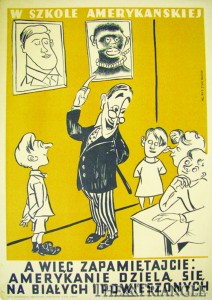After receiving a complaint from two Drexel Public Safety security officers, an unidentified Public Safety supervisor removed a 50-year-old Polish poster from an exhibition on the second floor of Nesbitt Hall, damaging the work in the process, April 12.

“We thought the poster was either vandalized or stolen,” David Raizman, the head of the Department of Media Arts in the Westphal College, said. Raizman was among the first people to notice the poster’s disappearance.
The theft was reported to the Drexel Police Department, who responded with a detective to the scene. After it was identified which poster was removed and the surveillance tapes of the floor were viewed, the poster was quickly tracked down and returned to the Department of Media Arts.
“Once we figured out what the subject matter was, it was pretty easy to figure it out that someone was offended,“ Raizman said.
The three Public Safety officials involved, all of whom were African American, did not know “what the captions translated into, and felt this poster’s imagery was culturally offensive” according to a statement given by Domenic Ceccanecchio, the senior associate vice president for Public Safety.
“The image was strong enough on its own to deliver offense,” Sandy Stewart, a professor at Drexel University and previously one of the program directors for Graphic Design, said. “Although I am in no way condoning the act of vandalizing an exhibit we can certainly understand how there was a miscommunication. [However,] the idea of censorship in an institution of higher learning is not an acceptable action.”
Public Safety officials investigated the matter further after returning the poster to the Media Arts department.
“The Public Safety supervisor on-duty that evening believed that he was acting in good faith and in the best interest of the University by removing what he felt was an offensive poster before it could be viewed by students, faculty and/or staff,” Ceccanecchio said. “As a result of the subsequent investigation, it was determined that he exercised poor judgment and did not take the appropriate action. He has since been removed from Drexel University.”
For the graphic design faculty, the controversy surrounding the poster design reinforced the strong impact that visual imagery has on viewers.
“It was interesting to us,” Raizman said, “that a poster from 1951 could be so influential and it sort of reminded everybody of the power of visual communication especially when taken out of context.”
Prior to this incident, the posters had not been given captions with translations because Drexel’s resident scholar Dr. Jeremy Aynsley, who was responsible for curating the exhibit and hand selecting the displayed posters, was giving private tours to explain the significance of each poster.
The poster’s original caption in Polish read, “So remember: Americans are divided between white people and hung people.” Meant as anti-Western, anti-capitalist propaganda, the image was commenting on racial relations in the United States.
“There was a language barrier,” Stewart said. “If they had been able to read Polish, they would have seen that it was in fact a criticism of the American nation’s policies of the time.”
“I wasn’t surprised that they were offended by it. It’s an offensive poster,” graphic design program director Jody Graff said. “But you register your complaints in a proper way. And we are unbelievably fortunate that the poster wasn’t damaged more than it was.”
The poster had one of its corners accidentally torn when being removed from the protective Plexiglas that held it in place. It was then rolled up, a practice that can be damaging for older archival documents, and remained in that fashion until its return.
Despite the damage that the poster suffered, “it was clear the intent was not to destroy it,” Graff said. “The intent was to remove it.”
The poster has not been returned to its display case due to the damage that it received during removal.
“We weren’t willing to risk putting it back up because it is unique,” Graff said. “It’s entirely possible that it’s the only one of its kind.” Instead, a digital copy of the poster was printed from the archives displayed next to a detailed caption explaining the meaning of the poster’s text and its historical significance.
“The idea that understanding the way information is perceived is critical to understanding how we communicate in the media and it is important for artistic expression to be preserved,” Stewart said. “But we can’t have vigilante critics looking at exhibitions of artwork in any venue, least of all in an academic setting.”
The posters will remain on display on the second floor of Nesbitt Hall until Wednesday, May 4.

